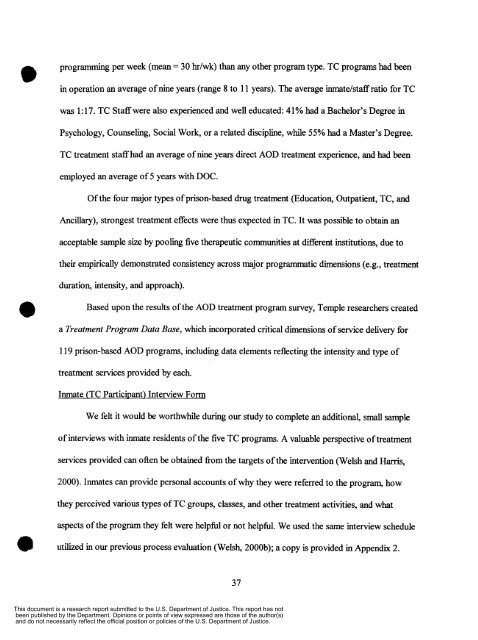0 - National Criminal Justice Reference Service
0 - National Criminal Justice Reference Service
0 - National Criminal Justice Reference Service
You also want an ePaper? Increase the reach of your titles
YUMPU automatically turns print PDFs into web optimized ePapers that Google loves.
programming per week (mean = 30 hr/wk) than any other program type. TC programs had been<br />
in operation an average of nine years (range 8 to 11 years). The average inmatelstaff ratio for TC<br />
was 1 : 17. TC Staff were also experienced and well educated: 41 % had a Bachelor’s Degree in<br />
Psychology, Counseling, Social Work, or a related discipline, while 55% had a Master’s Degree.<br />
TC treatment staff had an average of nine years direct AOD treatment experience, and had been<br />
employed an average of 5 years with DOC.<br />
Of the four major types of prison-based drug treatment (Education, Outpatient, TC, and<br />
Ancillary), strongest treatment effects were thus expected in TC. It was possible to obtain an<br />
acceptable sample size by pooling five therapeutic communities at different institutions, due to<br />
their empirically demonstrated consistency across major programmatic dimensions (e.g., treatment<br />
e<br />
duration, intensity, and approach).<br />
Based upon the results of the AOD treatment program survey, Temple researchers created<br />
a Treatment Program Data Base, which incorporated critical dimensions of service delivery for<br />
119 prison-based AOD programs, including data elements reflecting the intensity and type of<br />
treatment services provided by each.<br />
Inmate (TC Participant) Interview Form<br />
We felt it would be worthwhile during our study to complete an additional, small sample<br />
of interviews with inmate residents of the five TC programs. A valuable perspective of treatment<br />
services provided can often be obtained fiom the targets of the intervention (Welsh and Harris,<br />
2000). Inmates can provide personal accounts of why they were referred to the program, how<br />
they perceived various types of TC groups, classes, and other treatment activities, and what<br />
aspects of the program they felt were helphl or not helpful. We used the same interview schedule<br />
utilized in our previous process evaluation (Welsh, 2000b); a copy is provided in Appendix 2.<br />
37<br />
This document is a research report submitted to the U.S. Department of <strong>Justice</strong>. This report has not<br />
been published by the Department. Opinions or points of view expressed are those of the author(s)<br />
and do not necessarily reflect the official position or policies of the U.S. Department of <strong>Justice</strong>.
















